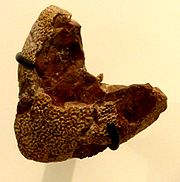
Pantylus
Encyclopedia

Lepospondyli
Lepospondyli are a group of small but diverse Carboniferous to early Permian tetrapods. Six different groups are known, the Acherontiscidae, Adelospondyli, Aïstopoda, Lysorophia, Microsauria and Nectridea, and between them they include newt-like, eel- or snake-like, and lizard-like forms, along...
amphibian
Amphibian
Amphibians , are a class of vertebrate animals including animals such as toads, frogs, caecilians, and salamanders. They are characterized as non-amniote ectothermic tetrapods...
from the Permian
Permian
The PermianThe term "Permian" was introduced into geology in 1841 by Sir Sir R. I. Murchison, president of the Geological Society of London, who identified typical strata in extensive Russian explorations undertaken with Edouard de Verneuil; Murchison asserted in 1841 that he named his "Permian...
period of North America.
Pantylus was probably a largely terrestrial animal, judging from its well-built legs. It was about 25 centimetres (10 in) long, and resembled a lizard with a large skull
Skull
The skull is a bony structure in the head of many animals that supports the structures of the face and forms a cavity for the brain.The skull is composed of two parts: the cranium and the mandible. A skull without a mandible is only a cranium. Animals that have skulls are called craniates...
and short limbs. It had numerous blunt teeth, and probably chased after invertebrate
Invertebrate
An invertebrate is an animal without a backbone. The group includes 97% of all animal species – all animals except those in the chordate subphylum Vertebrata .Invertebrates form a paraphyletic group...
prey.

